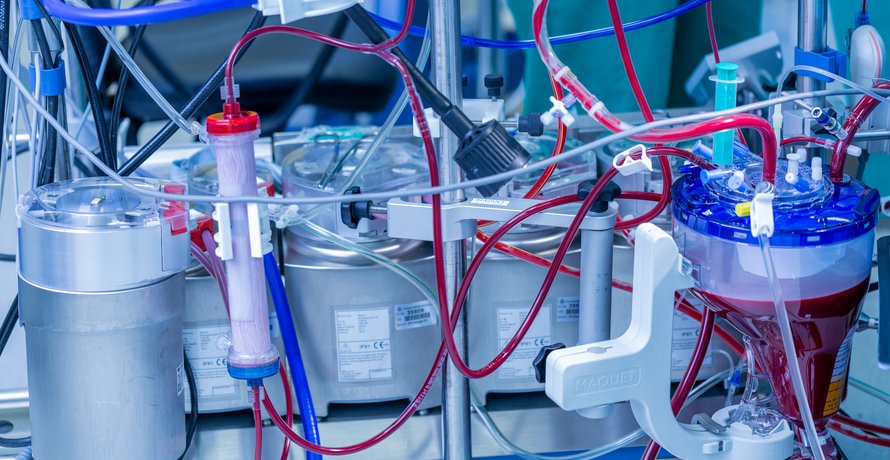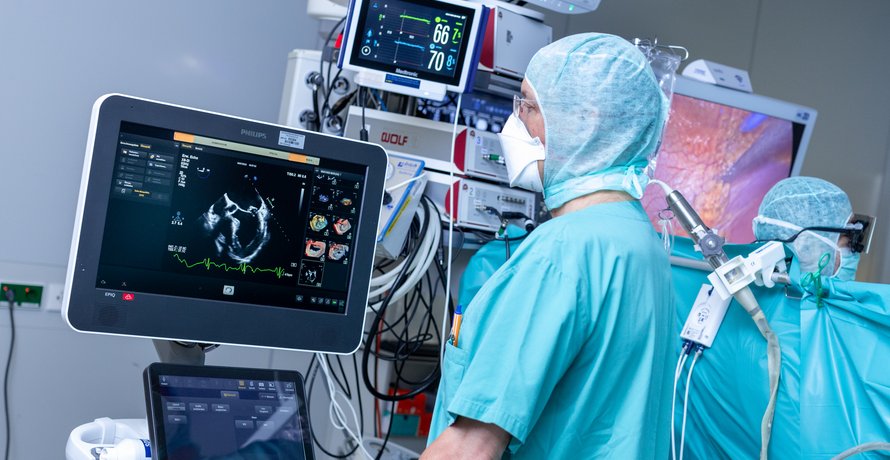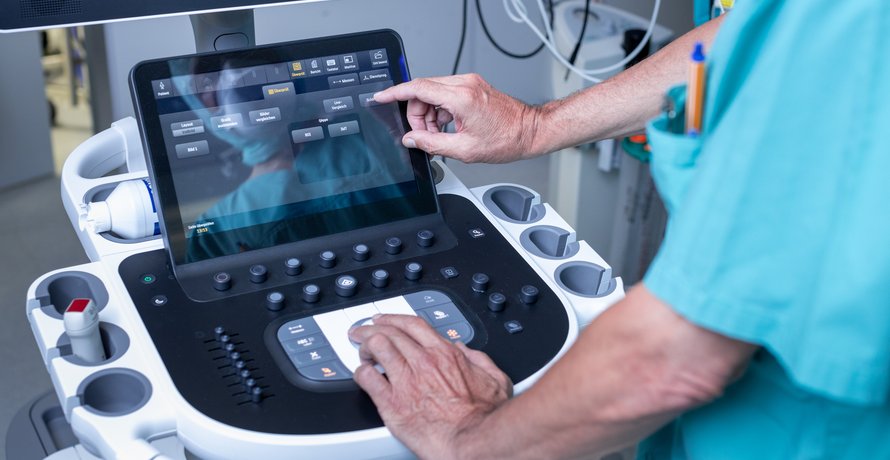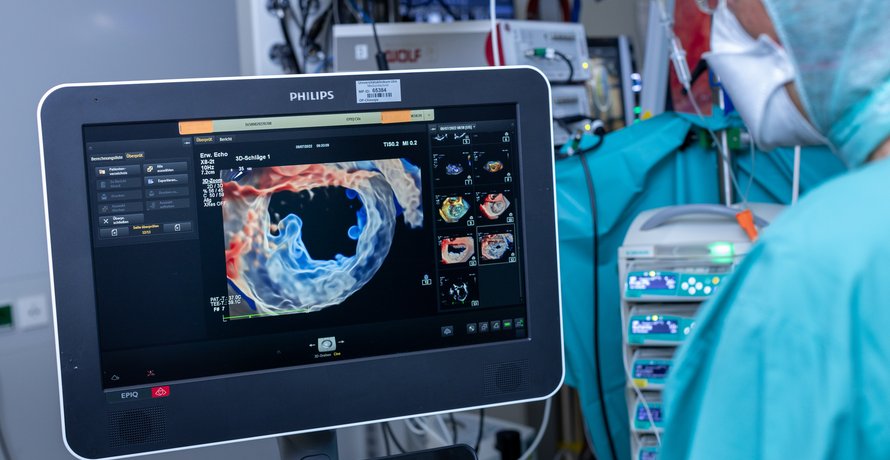Kardioanästhesie - Höchste Expertise für bestmögliche Patientensicherheit
Die Kardioanästhesie am Universitätsklinikum Ulm steht seit ihrer Gründung im Jahr 1997 für höchste medizinische Qualität und den Einsatz modernster Technologien in der Betreuung von Patientinnen und Patienten mit Herzerkrankungen und Erkrankungen der thorakalen Aorta. Unser spezialisiertes Team aus erfahrenen Fachärztinnen und Fachärzten begleitet jährlich jeweils ca. 1000 herzchirurgische und kardiologische Eingriffe und gewährleistet mit herausragender fachlicher Expertise höchste Sicherheit und optimale Behandlungsergebnisse. Um eine exzellente klinische Versorgung und einen hohen Ausbildungsstandard sicherzustellen, folgen wir konsequent den Empfehlungen der Deutschen Gesellschaft für Anästhesiologie und Intensivmedizin (DGAI).
Interdisziplinäres Herzzentrum – für eine exzellente Versorgung herzkranker Patient*Innen
Das Universitätsklinikum Ulm verfügt über ein hochmodernes interdisziplinäres Herzzentrum, in dem die Fachbereiche Kardiologie, Herzchirurgie und Kardioanästhesie Hand in Hand arbeiten. Durch diese enge Vernetzung gewährleisten wir eine umfassende und patientenorientierte Versorgung auf höchstem wissenschaftlichen Niveau – von der Diagnostik über interventionelle und chirurgische Behandlungen bis hin zur intensivmedizinischen Nachsorge. Unser Erfolg beruht auf einer intensiven interdisziplinären Zusammenarbeit zwischen Kardioanästhesie, Intensivmedizin, Kardiologie und Herzchirurgie. Dieser integrative Ansatz ermöglicht eine kontinuierliche Optimierung der Behandlungsstrategien und eine personalisierte Therapie, die auf die Bedürfnisse unserer Patient*innen zugeschnitten ist.
Herzchirurgie – Minimal-invasive Eingriffe für eine schnellere Genesung
Die Herzchirurgie mit ihren Schwerpunkten Chirurgie der thorakalen Aorta und Mitralklappenchirurgie führt täglich Eingriffe in zwei hochmodernen Operationssälen durch. Sie setzt dabei einen besonderen Fokus auf minimal-invasive Operationsverfahren, um die Erholungszeit der Patientinnen und Patienten zu verkürzen.
Kardiologie – Innovative kathetergestützte Verfahren
Die Kardiologie unseres Hauses ist spezialisiert auf minimal-invasive kathetergestützte Verfahren und führt täglich Edge-to-Edge-Verfahren von AV-Klappeninsuffizienzen sowie Aortenklappenimplantationen (TAVI) durch. Zudem werden angeborene Herzfehler in einem hochmodernen Herzkatheterlabor versorgt.
Kardioanästhesie – Präzise Steuerung und perioperative Sicherheit
Die Kardioanästhesie spielt eine zentrale Rolle in der Behandlung herzkranker Patientinnen und Patienten am Universitätsklinikum Ulm. Durch den Einsatz modernster Monitoring-Technologien, der intraoperativen transösophagealen Echokardiographie (TEE) und einer sehr hohen fachlichen Expertise wird eine individuell angepasste, qualitativ hochwertige und möglichst sichere Narkose- und Kreislaufsteuerung gewährleistet.
Die postoperative Betreuung der herzchirurgischen Patient*innen erfolgt auf unserer anästhesiologisch geführten Intensivstation. Das Team mit besonderer Kardioanästhesie-Expertise gewährleistet eine qualitativ hochwertige Versorgung und unterstützt die Patient*innen während ihres Heilungsprozesses mittels Frühmobilisation und Fast-Track-Konzepten.
Die Kardioanästhesie am Universitätsklinikum steht für exzellente Patientenversorgung auf höchstem Niveau. Mit modernster Medizintechnik, langjähriger Erfahrung und wissenschaftlich fundierten Therapiekonzepten sorgen wir für Sicherheit, Qualität und eine schnelle Erholung unserer Patient*innen.
Weiterbildung der Sektion Kardioanästhesie
Für die Fachärzt*Innen der Klinik für Anästhesiologie und Intensivmedizin besteht die Möglichkeit die Ausbildung zur/m Kardioanästhesie-erfahrenen Anästhesistin/en zu absolvieren. Während dieser Zeit werden die Fachärztinnen und Fachärzte in den ersten Monaten unter 1:1 Betreuung eingearbeitet, um eine strukturierte und umfassende Weitergabe der klinischen Expertise zu gewährleisten und sehr schnell die transösophageales Echokardiographie-Expertise zu entwickeln. Der Erwerb der neuen DGAI-Zertifizierung „Anästhesie bei herzchirurgischen und interventionellen kardiologischen Eingriffe“ wird von der Sektions- und Klinikleitung unterstützt. Weiters werden alle Echokardiographiekurse für den Erwerb des DGAI-Zertifikats für transösophageale Echokardiographie (TEE) und perioperativ fokussierte Echokardiographie (PFE) hausintern angeboten.
Hospitation in der Kardioanästhesie
Hospitationen in der Kardioanästhesie sind nach Terminvereinbarung gerne möglich. Diese können tageweise oder auch wochenweise erfolgen.
Im Rahmen einer Hospitationswoche erhalten Sie einen tiefen Einblick in das Gebiet der Kardioanästhesie. Dabei können Sie sowohl die perioperative als auch die postoperative intensivmedizinische kardioanästhesiologische Betreuung kardiochirurgischer Patienten näher kennenlernen.
Das operative Spektrum umfasst u.a.:
- offene und minimalinvasive Bypasschirurgie
- offene und minimalinvasive Klappenchirurgie
- Operationen an der thorakalen Aorta
- Implantation von Assist Devices (ECMO, VAD)
- interventionellen Klappeneingriffen (TAVI, Edge-to-edge Verfahren, perkutaner Klappenersatz)
Bei Interesse können Sie gerne unter ains@uniklinik-ulm.de einen Termin vereinbaren.
Paediatric anaesthesia
At Ulm University Hospital, we perform around 3,500 anaesthetics on children under the age of 18 every year. We care for the smallest premature babies weighing less than 500 grams as well as young adults. With our competent team, we are at the side of our young patients during operations and diagnostic procedures for which anaesthesia is necessary. All team members, both doctors and nurses, are experienced in dealing with children's fears and parents' worries. Everyone endeavours to make the time in hospital as pleasant as possible for the child and parents. Our aim is to ensure maximum safety, freedom from pain and anxiety and comfort for the child. A decisive factor in this is taking into account the special requirements for optimum child- and parent-orientated care.
During a preliminary anaesthetic consultation, we will discuss all the details and possibilities of anaesthesia with you and your child. One of our main aims is to take away your child's fear of anaesthesia during the preliminary consultation by involving your child and dealing with each child individually. All questions are answered and the optimal concept is determined. At the end of the preliminary consultation, you and your child give us your consent for the anaesthetic to be carried out.
During the operation, our team, consisting of an anaesthetist and a nurse anaesthetist, will look after your child. All team members are experienced in anaesthetising children. They will ensure that your child falls asleep relaxed, that the anaesthetic is stable and that they wake up pain-free.
What do my child and I need to consider?
To avoid complications caused by a full stomach, your child must not eat or drink anything for a certain period of time before the anaesthetic. Your anaesthetist will tell you the exact fasting times for your child. In general, the following rules apply:
All children may and should drink clear liquids (water, tea, clear juice spritzers) up to 1 hour before the start of the operation.
Newborns and infants may be breastfed (breast milk) up to 3 hours before the anaesthetic or bottle-fed ("formula milk") up to 4 hours beforehand.
All children may drink all types of milk (e.g. cow's milk, chocolate/strawberry milk) up to 4 hours before the anaesthetic.
All children may eat up to 6 hours before anaesthesia (solid meal).
After the anaesthetic, children may drink again (e.g. water, tea, spritzer, milk etc.) as soon as they are awake and like it. If this is well tolerated, they may also eat. There are exceptions to this for a few operations, which you will be informed about in the recovery room.
Team
Die Sektion Kinderanästhesie wird von Prof. Dr. Sebastian Schmid in enger Abstimmung mit der Klinikdirektorin Prof. Dr. Bettina Jungwirth geleitet. Ein Team aus 6-7 Fach- und Oberärzt*innen mit besonderer Erfahrung im Bereich der Kinderanästhesie steht jederzeit an 365 Tagen im Jahr im Rahmen eines Hintergrunddienstes für die optimale Versorgung der Kinder zur Verfügung. Weitere 6-7 Fach- und Oberärzt*innen, die regelmäßig Kinder betreuen, übernehmen die Versorgung im OP und in den anderen Bereichen der Klinik (Radiologie, Kinder-Pulmonologie oder Gastroenterologie etc.).
Weiterbildung Kinderanästhesie - Fellowship
Für Anästhesist*innen mit besonderem Interesse im Bereich der Kindermedizin bieten wir intern ein mindestens 12-monatiges kinderanästhesiologisches Fellowship an. In unserer Klinik vertiefen die Fellows Wissen, Fertigkeiten und Erfahrungen bei der perioperativen Versorgung von kritisch kranken oder verletzten Kindern und Jugendlichen.
Das Fellowship-Programm ermöglicht die strukturierte fachliche Weiterentwicklung im Bereich der Kinderanästhesiologie, um die persönliche Expertise in diesem Spezialgebiet auszubauen. Die Facharztweiterbildung bzw. die Musterweiterbildungsordnung in Deutschland werden von diesem Fellowship-Programm nicht tangiert.
Präambel Fellowship Kinderanästhesie
Fellowship Curriculum
Übersicht Fellowship Kinderanästhesie:
- 12 Monate (oder länger) intensive Ausbildung mit einem Schwerpunkt in der Kinderanästhesie
- Teilnahme an einem anerkannten Repetitorium Kinderanästhesie (bzw. künftig an Webinaren der AG Fellowship Kinderanästhesiologie)
- Gültiges EPALS-Zertifikat
- Besuch einer mindestens eintägigen Fortbildungsveranstaltung mit kinderanästhesiologischem Schwerpunkt
- Teilnahme an mindestens einem kinderanästhesiologischen Kongress
- Vortrag oder Fallpräsentation auf einer kinderanästhesiologischen Fortbildungsveranstaltung
oder Übersichtsartikel für das DGAI-geförderte Register OrphanAnesthesia
oder Übersichtsartikel zu einem kinderanästhesiologischen Thema
oder Erarbeitung klinikinterner kinderanästhesiologischer SOPs - Abschließendes Fachgespräch






